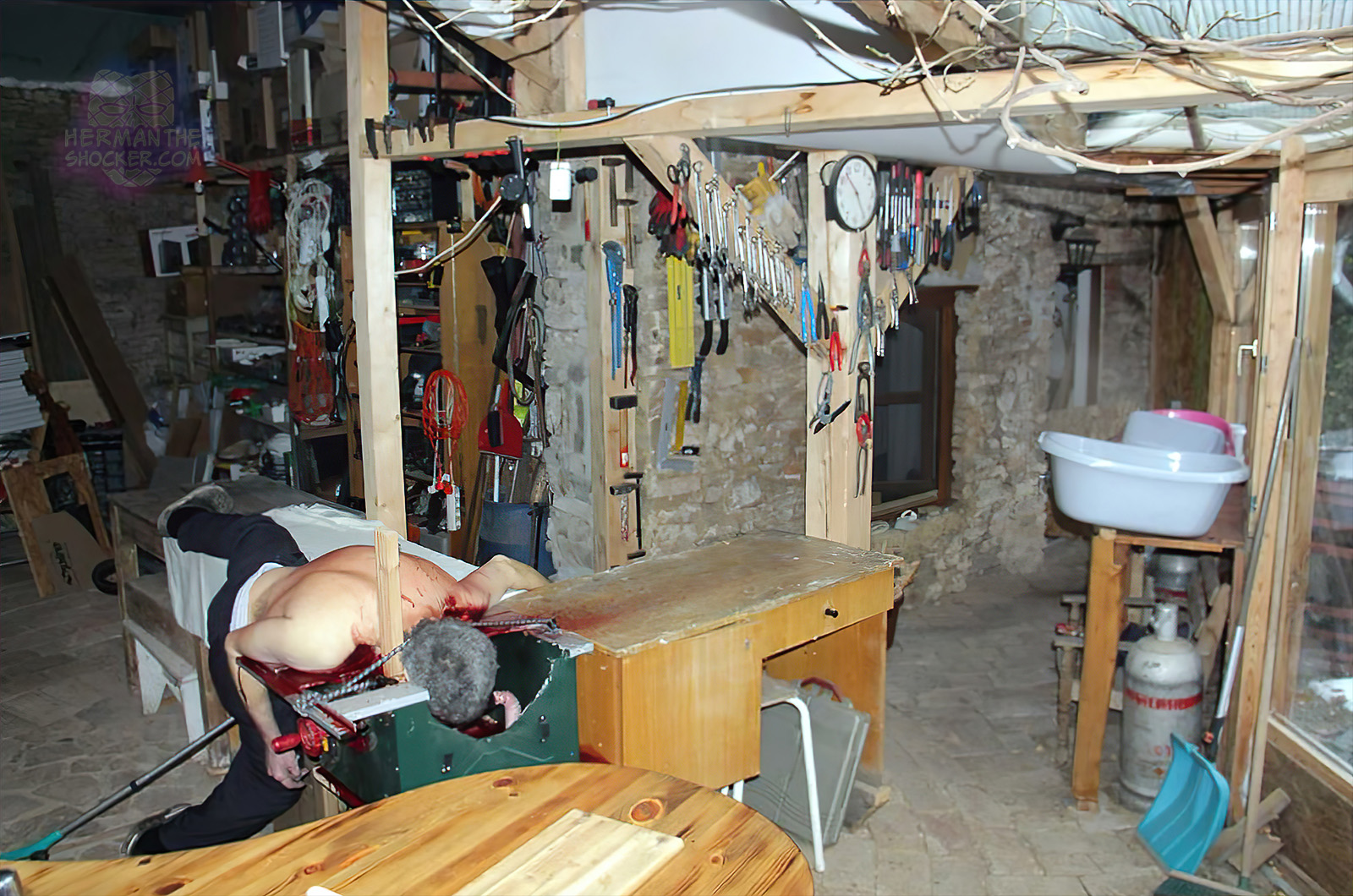Hungary. A man received an email from his 51-year-old brother that he was planning to commit suicide. He rushed to his brother’s house, and as he looked through the window of the wooden outbuilding, he spotted the blood-soaked body of his brother lying with his head on a table saw. He called the emergency services and turned off the outside situated fuse thus stopping the rotating saw. The locked door of the building was opened by the arriving police officers.
The body of the victim was lying prone on a table covered with a white sheet, while his neck and head were lying on a table saw situated directly alongside the table (Figs.1-4). Apart from the blood, the sheet was clean. A large removable rectangular metal plate was missing from the surface of the saw near the blade, and an adjacent large non-removable aluminum piece was also cut out. A rectangular wooden lath was installed vertically into the place of the removed metal plate adjacent to the front end of the blade, and it was wired to the framing (Figs.6-7). A semicircle metal piece was also cut out from the side of the table saw (Fig.8) The victim’s neck was positioned on the blade, and the neck was pressed against it with a bungee cord that was fixed with its hooks to the frame of the saw and positioned above the neck. The face was positioned downwards above the missing parts of the table saw. The green “power on” button was pushed in. The removed parts of the saw were found in the same building on a workbench.
No sign of struggle was found during the examination of the body at the death scene. Hypostasis and rigor mortis was not observed, while the rectal temperature was 35.3°C (95.5°F). The victim previously worked as a fireman, and he was injured in service four years prior to the suicide while sliding head-first down 10 stair treads. He suffered a concussion and developed peroneal paresis and back pain. His complaints were gradually increasing and he developed depression and chronic pain syndrome.
Five months before the suicide and during his last hospital admission, he complained about severe pain. The victim was living alone; he was mostly bedridden and had limited self-sufficiency. He was using crutches to move within the house, but he was not able to leave his home without help. The victim was diagnosed with depression three years before but was not under regular psychiatric treatment prior to his death (he had not sought medical care recently). Previous psychological evaluation showed mixed anxiety-depression disorder, somatization, and conversion mechanism.
Autopsy results
At the start of the autopsy, a gaping injury was found on the neck extending to the upper part of the trunk (Fig.9). The edges of the wound were sharp, abraded, and partially charred. The right end of the wound in the right supraclavicular region was smooth and circular. The wound ended in multiple parallel triangular cut marks on the left shoulder (Figs.10-12). The soft tissues of the neck and left supraclavicular regions were severely damaged and partially charred.
The trachea was transected right below the larynx, and parts of the carotid arteries, jugular veins, and vagus were missing at the same level on both sides. The thoracic cavity was opened on both sides at the upper portion near the neck transection. The fourth, fifth, and sixth vertebrae were severely damaged with horizontal cut marks on the remaining parts. The body of the fifth vertebra was destroyed, which made the macroscopically intact spinal cord visible (Fig.13). A large reddish abrasion was visible on the upper part of the neck and on the chin with large parts of the beard missing (Fig.11). A sharp cut mark was found on the left clavicle, left acromion, and left humerus head (Figs.14-17). 1000 ml of blood was found on both sides of the thoracic cavity. A minimal amount of blood was found in the bronchi.
The air-embolism test was negative—which was performed by filling the pericardial sac with water and opening the ventricles to observe emerging air bubbles. The spleen was hypovolemic, the cortex of the kidneys was pale brownish, and the medulla was slightly reddish. During the histological examination, fresh bleeding was seen in the spinal cord and other samples from the injured tissues. Toxicological analysis of the blood and urine using the following systems was negative.
Discussion
Accidental table saw injuries are common and approximately 30,000–40,000 injuries by table saw occur in the United States annually. Nearly half of all saw-related amputations are caused by table saws. Victims that commit suicide by table saw primarily target the neck. The mechanism of death in neck injuries is always exsanguination due to injury of the large vessels, but some blood aspiration also occurs.
During the reconstruction of events in table saw fatalities, the analysis of circumstances and injuries is important to differentiate between murder, suicide, or accidents. Signs of struggle (e.g., broken furniture), grab marks, and defensive wounds suggest murder. The presence of a suicide note, information about previous suicide attempts or suicidal thoughts, presence of scars from previous suicidal incisions, or tentative cuts indicate suicide. The presence of abrasion, contusion, or laceration by a blunt force impact on the head suggests an accident due to a kickback, occurring when the victim fell down on the rotating blade after getting hit by the timber kicked back by the saw. During the “normal” use of a table saw, the operator is standing in front of the table in line with the rotating blade, so if he falls down on the blade, it will cause vertical head or neck injury. In contrast, the injury is more horizontal in suicides.
In the present case, the injuries were much more severe and deeper because the modifications of the saw enabled deeper cutting and continuous contact between the blade and the neck of the victim. The modifications probably were made purposefully for committing suicide: removing that large part from the saw would not allow firm horizontal positioning of the timber thus making firm hold not possible, and the witnesses asked by the police did not observe these modifications previously. The modifications were sophisticated; the front and superior plate were removed which allowed enough space for deeper cutting of the head, the bungee cord continuously pressed the neck vertically onto the blade, and the wooden lath prevented the neck from sliding away from the blade.
The parallel cut marks seen on the vertebrae and at the left end of the wound illustrate how the cutting depth gradually increased with every rotation of the blade while the head gradually angled down. Apart from the email sent prior to the act, multiple findings support that the victim committed suicide: the arms of the victim were close enough to the power switch to turn the switch on; the presence of the crutch indicated that the victim went to the saw on his own accord; no injuries other than those caused by the saw were found during the autopsy, and the door of the building was locked from inside.
Latest posts





















 US ☎︎ 988 or 1-800-273-TALK (8255)
US ☎︎ 988 or 1-800-273-TALK (8255) CA ☎︎ 1-833-456-4566
CA ☎︎ 1-833-456-4566 UK ☎︎ 0800-689-5652
UK ☎︎ 0800-689-5652 AUS ☎︎ 13-11-14 or 1300-659-467
AUS ☎︎ 13-11-14 or 1300-659-467 ROK ☎︎ 1393
ROK ☎︎ 1393 DE ☎︎ 0800-111-0-111
DE ☎︎ 0800-111-0-111 ES ☎︎ 024
ES ☎︎ 024




